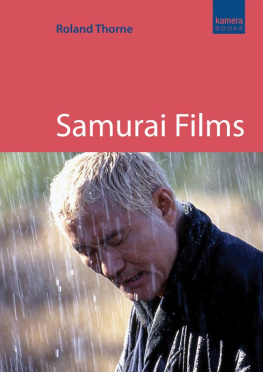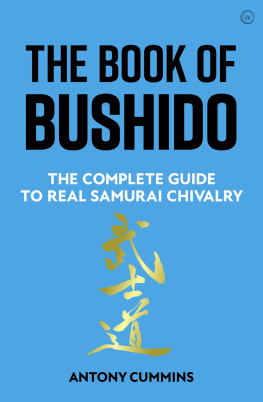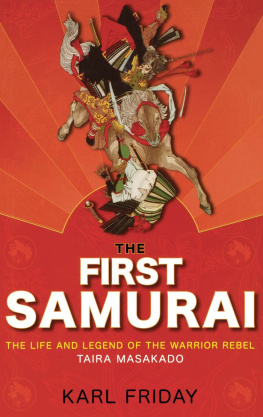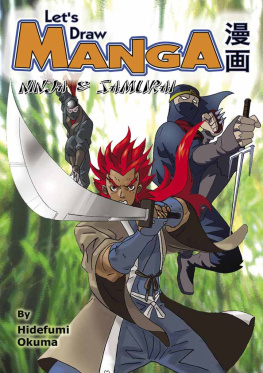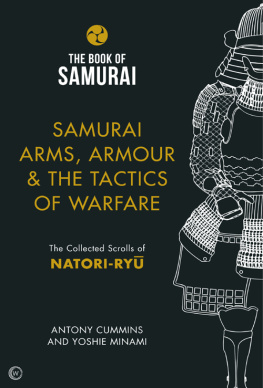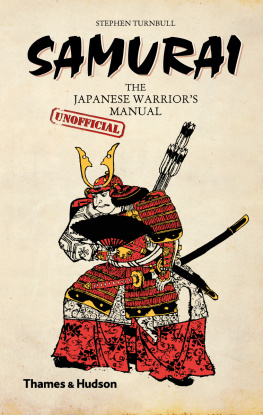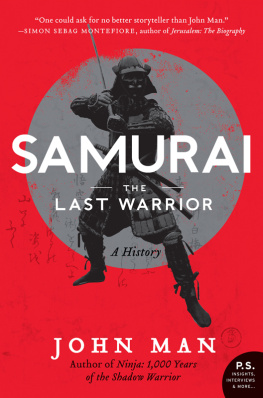Roland Thorne - Samurai Films.
Here you can read online Roland Thorne - Samurai Films. full text of the book (entire story) in english for free. Download pdf and epub, get meaning, cover and reviews about this ebook. City: Harpenden, year: 2010, publisher: Oldcastle Books, genre: Non-fiction. Description of the work, (preface) as well as reviews are available. Best literature library LitArk.com created for fans of good reading and offers a wide selection of genres:
Romance novel
Science fiction
Adventure
Detective
Science
History
Home and family
Prose
Art
Politics
Computer
Non-fiction
Religion
Business
Children
Humor
Choose a favorite category and find really read worthwhile books. Enjoy immersion in the world of imagination, feel the emotions of the characters or learn something new for yourself, make an fascinating discovery.
- Book:Samurai Films.
- Author:
- Publisher:Oldcastle Books
- Genre:
- Year:2010
- City:Harpenden
- Rating:4 / 5
- Favourites:Add to favourites
- Your mark:
- 80
- 1
- 2
- 3
- 4
- 5
Samurai Films.: summary, description and annotation
We offer to read an annotation, description, summary or preface (depends on what the author of the book "Samurai Films." wrote himself). If you haven't found the necessary information about the book — write in the comments, we will try to find it.
Samurai Films. — read online for free the complete book (whole text) full work
Below is the text of the book, divided by pages. System saving the place of the last page read, allows you to conveniently read the book "Samurai Films." online for free, without having to search again every time where you left off. Put a bookmark, and you can go to the page where you finished reading at any time.
Font size:
Interval:
Bookmark:
For Mum, Dad and Sal.
Special thanks to Craig Cormick, for his vital help and encouragement during the early stages of this project. Thanks also to those who have taught me the most about film and writing: Dave Watson, Francesca Rendle-Short and Felicity Packard. Thanks to my good friend Chris Quaddy Williams for his invaluable help with the frame grabs. Thanks to those who have already written on this fascinating subject, mainly Mitsuhiro Yoshimoto, Alain Silver and Patrick Galloway. Thanks to Eastern Eye for making so many of these wonderful films available in Australia. And, of course, a big thanks to Hannah Patterson, for seeing the potential of a Kamera Book on samurai films.
Imagine a mountain top, with long grass undulating in the unrelenting wind. Two figures come into view, a few short paces away from each other. Their firm stance conveys pride, determination and a strange sort of calm. In a flurry of motion, one of the men draws his sword, quickly followed by the other. With a flash of blades, and a mist of blood, it is over. One man walks away, the other doesnt. Who are these men? How did they get to the point where violence was the only way to settle their dispute? And why did they both seem unafraid to die? Welcome to the world of the samurai film.
Samurai films come in many flavours: there are the basic action movies, beautiful in their brutal simplicity, the meaningful and moving tales of the individuals struggle to survive, and the expansive, epic films that tell tales of famous personalities. In short, theres something to please every fan of genre cinema. Within the pages of this book youll find everything you need to begin or continue an interest in this highly entertaining and unique genre. Theres basic information on the samurai and their world, details on the major directors and stars, and reviews of some of the finest films in the genre.
Every film reviewed here is easily available. This is a rule Ive stuck to fervently while writing this book. It meant excluding some great films, such as Hideo Goshas Tenchu, but if you cant easily see them Ive decided not to extensively review them. There are few things I find more frustrating than buying a book about a genre, and discovering that most of the films reviewed have not been available for many years. At the time of writing, all but four of the films reviewed in this book are available on DVD from Amazon.com. These four films Three Outlaw Samurai, Bandits vs. Samurai Squadron, Hunter in the Dark and Samurai Saga can be purchased from importers, and are not at all hard to find.
So, happy viewing Many excellent films await you.
In Japanese, it is the family name that comes first when an individuals name is included in any form of text. This is the opposite of the convention in English, where the family name comes second. For example, in English my name is written Roland Thorne, but in traditional Japanese I might be referred to as Thorne Roland. To avoid confusion for those with only a limited knowledge of the Japanese language (a category I certainly fall into) I have chosen to follow the English convention in this book. As you explore the samurai film genre, you will probably notice that some books, articles and sub-titles on some of the films follow the Japanese convention.
Put simply, the samurai were a warrior class, forming the armies of feudal leaders during Japans many civil wars between the 10th and 15th centuries, and during the relatively peaceful Tokugawa period (1603-1868). They wore distinctive armour and fought with weapons and styles unique to Japan.
There are many aspects of the samurais life which constantly crop up in samurai films, and these may confuse those unfamiliar with them. What follows is a summary of the main issues of samurai life, which are commonly referenced in the films, as well as a brief summary of the historical periods in which the films are usually set.
The importance of the samurai in Japans early civil wars gradually led to them becoming an important social class, the more powerful samurai becoming daimyo, feudal lords ruling a clan, and the warriors and peasants beneath him. Many of these daimyo began to study the fine arts, in what has been described by many scholars as an attempt to legitimise their rule over the uneducated peasants. Most of these daimyo insisted their samurai do the same, so the samurai became a highly educated warrior class, not only skilled at warfare, but also at arts such as painting, sculpture, calligraphy, poetry, and traditional dance and theatre. This created in the samurai an interesting contradiction: a man who could write a beautiful haiku one day, and strike his enemy down the next. Of course, to the samurai, there was no contradiction; both poetry and swordsmanship were considered arts, and there was beauty to be found in both.
The daisho were the two swords carried by the samurai, usually a katana (long sword) and a wakazashi (short sword). In the Tokugawa period there was actually a law which stated only samurai were allowed to carry both a short and long blade. These swords were immensely important to the samurai; they symbolised his position in the warrior class, and were described by many as the very soul of the warrior. Even a samurai in the most desperate of situations would be loath to give up his swords.
Focused on honour and obedience, the code of bushido has done much to colour how we view the samurai, specifically giving rise to the myth of all samurai being morally outstanding individuals obsessed with honour. The underlying principles of the bushido code are loyalty and obedience; the ideal samurai puts the wishes of his daimyo and clan above his own, and is prepared to die for them. Also important to bushido is a sense of honour, something which was tied closely to each samurais reputation.
However, the historical reality is far from the ideal. Any close examination of how the samurai conducted themselves in times of war reveals that the vast majority followed the bushido code only when it suited them. In truth, the samurai were much like many other warrior classes which have arisen throughout history. They strove to be the best at warfare they possibly could, and placed more importance on victory than on honour.
Both the mythical bushido samurai and his more brutal historical counterpart, have been the subject of many Japanese films. Regardless of his mythic status, the samurai always makes a compelling protagonist.
Part of the bushido code focused on ritual suicide, known as seppuku, or, more crudely, as hara-kiri. A samurai could be ordered by his daimyo to commit seppuku in punishment for some wrongdoing, or may have chosen to do so in the hope of absolving himself of some personal shame. Seppuku could also be used as a form of protest, a signed letter outlining the samurais grievance. A death through seppuku was considered much more honourable than being killed by enemies, so if a battle was completely hopeless, a samurai might consider seppuku. The actual ritual involved making a long deep cut across the stomach. When this was done an assistant would complete the process by swiftly beheading the samurai, putting an end to his suffering.
The term ronin literally means wave man, suggesting an individual adrift on the ocean, his future decided by the uncaring waves and currents. Ronin were masterless samurai, and there were many ways a samurai could end up unemployed. He may have displeased his daimyo, and been dismissed from his service. When daimyo were defeated in battle, and their lands taken by another, their samurai were usually left unemployed. It was also possible to be born a ronin. The strict class system of feudal Japan made it difficult for the ronin to fit into society; no longer able to fulfil the role he was born to, the ronin was also often too proud to give up his swords and become a farmer or merchant. Some lucky ronin were able to find employment with other daimyo. Others became bandits, or bodyguards and teachers to wealthy members of the lower classes. Many suffered dire poverty, unable to afford food and lodgings. The Tokugawa period produced many ronin. With the Tokugawa government regularly dissolving clans which displeased them, many samurai were left homeless and unemployed, forced to wander the roads.
Font size:
Interval:
Bookmark:
Similar books «Samurai Films.»
Look at similar books to Samurai Films.. We have selected literature similar in name and meaning in the hope of providing readers with more options to find new, interesting, not yet read works.
Discussion, reviews of the book Samurai Films. and just readers' own opinions. Leave your comments, write what you think about the work, its meaning or the main characters. Specify what exactly you liked and what you didn't like, and why you think so.

